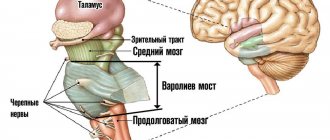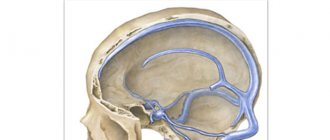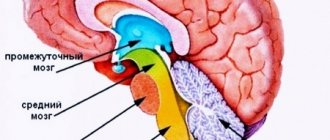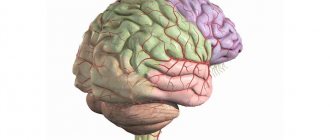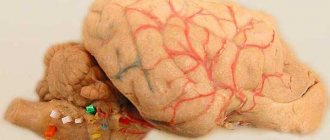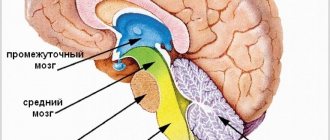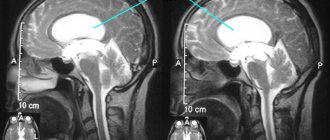Brain structure
Everyone knows that if the brain stops functioning, then a person does not react to any external factors, does not show any activity, and turns into a “vegetable.” The structure of the brain is symmetrical and consists of the right and left hemispheres.
Disputes between scientists do not subside, but some facts have been proven and approved.
Important facts:
- The human brain consists of 25 billion neurons.
- The adult brain makes up about 2% of body weight.
- The organ consists of three membranes: hard, soft, arachnoid. The shells perform the main – protective function.
It is generally accepted that the left hemisphere is responsible for all mental processes, and the right hemisphere for the perception of the outside world. Roughly speaking, the left is the logical hemisphere, and the right is the creative hemisphere.
From an anatomical point of view, the brain consists of the following parts:
- Medulla. Responsible for vegetative functions.
- Midbrain. Controls reflexes to external stimuli.
- Hindbrain. Responsible for coordination of movements.
- Diencephalon. Includes sensory centers (hunger, thirst, satiety, sleep regulation).
- Forebrain. The largest part, which is covered with grooves (convolutions). Provides better brain function.
Brain functions
It is almost impossible to list all the functions. Areas of the brain are responsible for all human actions in everyday life.
Main functions:
- Reasonable function, or human thinking.
- Processing of external signals that coordinates taste, vision, hearing, and smell.
- Managing psychological state and emotions.
- Regulation of basic movements, reflex function.
In ordinary life, a person does not think about why he acts one way or another. The brain is responsible for all actions.
Departments
If you delve into the topic, in order to determine which part of the brain is responsible for speech, you need to know what main sections this human organ consists of. They are usually called shares. The structure and functions of the cerebral hemispheres play a vital role in the life of each of us.
The human brain has the following lobes:
- Frontal.
- Temporal.
- Parietal.
- Occipital.
Separate from the structure and functions of the cerebral hemispheres, the cerebellum, which is responsible for coordinating the body in space, and the pituitary gland, which regulates the production of hormones, are distinguished.
Not in all cases, scientists agree on which part is responsible for what. This speaks first of all about the great lack of knowledge about the areas of the brain and the imperfections of modern medicine.
Features of the speech system
The centers of speech function located in the brain have undergone colossal changes in the process of human evolutionary development. A prerequisite for the development of speech in ancient people was the mobility of the lips and tongue (in comparison with animals). The speech system of a modern person conventionally consists of sections - central and peripheral. In the first case, we mean the Wernicke and Broca centers, which are located in the left hemisphere.
The peripheral department includes the hearing organs, articulatory and vocal apparatus. Many vowel sounds are reflexive in nature, which makes them dependent on physiological processes. For example, painful sensations are accompanied by involuntary groans “o” or “oh”, which are formed as a result of interruption of the respiratory movement during exhalation.
The anatomical and physiological mechanisms of speech and hearing formation reflect the activity of the corresponding centers that are located in the brain, mainly where the convolutions lie - the frontal and temporal. The brain centers, in particular Broca's and Wernicke's, play a decisive role in the formation of speech skills, and the location of both areas in the left hemisphere indicates the great importance of this hemisphere in the implementation of speech activity.
The functions of the individual areas of the brain responsible for speech vary. For example, the temporal lobe of the left hemisphere is responsible for auditory and speech memory. Damage to this part of the brain is associated with impaired understanding of the meaning of verbal stimuli. A person ceases to understand the words addressed to him, especially if their meaning depends on the context (within a sentence).
When parts of the brain such as Wernicke's area and posterior associative zones, which provide phonemic perception of speech, are damaged, the integration of speech elements into a single semantic scheme is disrupted. While maintaining the integrity of the designated brain structures and simultaneous damage to the frontal areas, understanding complex phrases and profound statements becomes difficult. Such symptoms are due to the loss of functions that are regulated by the frontal areas:
- The ability to plan and program actions.
- Cognitive activity, searching for the necessary information.
- Analysis of essential speech elements within a detailed, complex utterance.
Broca's center is a department that is responsible for a person's ability to pronounce words, which involves the ability to name objects and form phrases. This area of the brain is responsible for the implementation of speech, as it is presented orally; damage to the brain matter in this section is accompanied by stuttering on any syllable, repeated repetition of previous articulation, and rearrangement of letters in a word.
Other areas of the brain take part in the implementation of the speech function of the oral form. For example, to name a word, you need to recode a visual stimulus into an audio (vocal) equivalent. The operation involves the parietal and occipital structures. Maintaining a certain acoustic (related to auditory perception) structure of a word is impossible without the participation of the temporal region, which lies on the left side of the head.
Impaired naming of objects often occurs due to deterioration of complex processes occurring in the brain. For example, choosing the only correct option for the name of an object requires inhibition of other alternatives. The structures of the frontal cortex are involved in these processes.
Other important tasks of the frontal cortex are related to translating the intent of a phrase into verbal form. One of the leading symptoms of damage to the substance of the frontal lobes is the lack of speech initiative. Patients do not pronounce words independently without external stimuli. During the dialogue, patients behave passively and limit themselves to monosyllabic repetitions.
Anterior to the central sulcus of the frontal lobe is the supplementary motor area for speech. When this area is damaged, speech rhythm and intonation change. In this case, the patient loses the ability to correctly construct sentences - he misses prepositions and conjunctions, cannot choose the appropriate pronoun and put the verb at the right time.
Moreover, grammar suffers in one’s own oral and perceived speech of others. Broca's and Wernicke's areas, which are connected into a single system by a bundle of nerve fibers, are located in the left hemisphere. However, the structures of the right hemisphere are also involved in the formation of verbal signs. Damage to the brain matter in the right hemisphere leads to disorders:
- Changes in intonation components.
- Changing the pitch and strength (loudness) of the voice.
- Changing the emotional component of verbal sayings.
Vocal reactions are controlled by the limbic system, which provides spoken phrases with a certain emotional coloring. The right hemisphere contains structures that analyze verbal material at the visual-spatial level. During the instrumental examination, an increase in the activity of thalamic structures during the perception of speech stimuli is revealed.
Frontal lobe
Returning to the question of which part of the brain is responsible for speech, it is necessary to dwell on the study of the frontal lobe. First of all, there is a statement that the left hemisphere of the brain is responsible for the ability to speak. Speech centers are located here.
The frontal part of the cerebral hemispheres is of great importance in human daily life. She is responsible for:
- The nature of thinking.
- The process of urination.
- Maintaining the body in an upright position.
- Motivation and behavior control.
- Speech and handwriting.
The frontal lobe takes responsibility for the semantic construction of human speech.
Temporal lobe
The role of this part of the brain is not so extensive, but much more narrowly focused. The temporal lobes are located in both the left and right hemispheres of the brain, which affects their basic functions.
The left temporal lobe is responsible for:
- Perception of sound information.
- Short-term memory.
- Selection of words during a conversation (role in speech formation).
- Synthesis of visual and auditory information.
- Interaction of music and emotions.
The right temporal lobe is responsible for:
- Facial expression recognition.
- Perception of rhythm and musical tone.
- Perception of speech intonation.
- Recording visual facts.
This part of the brain allows a person to understand by the intonation of the interlocutor’s speech about his emotions and attitude to the issue under discussion.
PsyAndNeuro.ru
The neurological examination required for topical diagnosis traditionally includes an assessment of speech - an excellent example of how practical medicine (traditionally and not without success) relies on simplified explanations and temporary hypotheses. Unambiguous connections between function and anatomical region are no longer a relevant concept in neuroscience in general. But if localizationism “works” in the study of other neurological functions, then questions arise regarding the mechanisms of speech not only among neurologists, but also among psychiatrists. Some speech and language scientists categorically state that there are no speech-specific areas of the brain, and speech is "distributed" just like "memory" or "thinking." With this in mind, let us try to identify some trends in research into the neuroanatomy of speech.
1. Bigger and more accurate
Currently, aphasiology pins its hopes on big data, unlike the times of Broca and Wernicke, when a single clinical case was enough for the scientific community. But such large studies are technically complex, and meta-analyses remain subject to the problem of different conditions in each study, making comparisons only subject to certain limitations. In addition, the accuracy of voxel mapping depends on the capabilities of the technique used - for example, magnetic resonance imaging. At the moment, the generally accepted unit of such mapping is 1x1x1 mm or 3x3x3 mm, that is, on the one hand, localizationism no longer talks in terms of sulci and convolutions, but on the other hand, it is still a large group of neurons that randomly fall into one voxel. What does this cubic millimeter mean in terms of individual differences and how our brains change throughout life?
2. Translation from the language of linguistics [1]
Speech is not yet accessible to research in more complex (and more interesting from the point of view of psychiatry) aspects. Here we lack an understanding of how to separate it from other functions, and whether this is even possible if it completely permeates our experience. I remember the metaphor of Terrence Deacon, who wrote that speech colonizes our brain like a parasite. When trying to evaluate simpler functions, we encounter another problem: the linguistic terms in which language is described are difficult to translate into the language of biological functions.
For example, the diagram below lists horizontally the aspects that researchers artificially highlight in the speech function, and vertically lists specific tasks (or states of deficiency in a certain area) that make it possible to study these aspects. When presenting the tasks, the authors tried to take into account that none of them allows one to study any function in isolation from others. “Comprehensible” explanations of what function a given task (or speech disorder phenomenon) demonstrates to us are no longer considered sufficiently accurate, and modern research uses a data-driven approach, that is, the results obtained are grouped into based on statistical correlations after the fact. What neurobiological data we have regarding the mechanisms of speech, even in the simplest cases, concerns complex phenomena. It is always “many functions - many areas” and never “one function - one area”. Thus, even modern theories, which have long abandoned such terms as “Broca’s area” and “Wernicke’s area,” remain rather vague “working hypotheses.”
3. Dual flow model [2]
It is characteristic that the modern model of the cortical organization of speech perception was initially proposed not based on studies of speech itself. This scheme was first considered in relation to visual perception, proven in an experiment on monkeys using neurostimulation, and only then “adapted” in neurolinguistics. Two ways of processing visual information were identified, which were conventionally designated as “what” and “how”: one of them was intended for the actual recognition of an object, and the other for accessing the motor programs necessary to interact with this object. From this point of view, we can look at the perception of speech sounds: the areas and pathways known to us from earlier studies can be represented as two streams of information with different purposes. The so-called “ventral stream” involves the upper and middle parts of the parietal lobe; it is involved in the recognition of speech sounds and their subsequent semantic processing. The “dorsal stream” unites the posterior parts of the frontal lobe, the posterior parts of the temporal lobe and the parietal part of the insula - with its help, the relationship between perceived sounds and our own articulatory system is carried out. This view allows us to somewhat systematize our scattered knowledge: a significant part of the brain areas whose involvement in speech has been identified can be combined into a completely understandable system. The classical Wernicke-Lichtheim-Geschwind model fits quite organically here: the same arcuate fasciculus that connects “Broca’s area” and “Wernicke’s area” is one of the main components of the dorsal stream.
An interesting feature of this model is the distinction between the processes of perception and comprehension of speech, that is, it is assumed that they are not necessarily interrelated or that one of them precedes the other. In the brain, any process can occur completely differently, as we break it down into stages to make it easier to understand.
Another difference from the traditional model is the revision of the previously existing concept of interhemispheric asymmetry. Neuroimaging studies, including on patients who underwent the Wada test or callosotomy surgery, have shown that the hemispheres perform different, but equally necessary functions regarding the perception and production of speech. This is especially true for perception: it has been shown that both hemispheres individually are capable of providing a sufficient level of comprehension of information.
4. “Phonological” and “semantic” zones?
For a modern researcher, it is obvious that describing speech pathology in terms of a modern neurological examination (whether he understands and can speak) is too superficial an approach that does not allow one to take even a step in identifying neurophysiological mechanisms. The description according to the “linguistic principle” (whether the pathology belongs to the phonological or semantic sphere) is, apparently, also quite superficial, although more accurate than before. Perhaps due to technical limitations, but research to date has not yet revealed “stages” in information processing (for example, first sounds, then meaning). Apparently, the processing of data at each “level” occurs simultaneously, in parallel, but at the same time, data from different “levels” interact with each other.
However, it is within this paradigm that much modern research is conducted.
The following diagram is proposed by Gregory Hickok, one of the most influential researchers in modern neurolinguistics [1]
Figure a) schematically depicts the dual-flow model with some functional and anatomical additions, and also reflects the degree of lateralization of the functions in question. The elements of the dorsal and ventral stream are colored blue and pink, respectively. Under b) is a visual representation of the areas of the left and right hemispheres involved, as well as the connections between them.
-The dorsal surface of the superior temporal gyrus (STG), where the spectral and temporal characteristics of speech sounds are supposedly analyzed, is colored green.
–Yellow indicates the area around the superior temporal sulcus (STS), which is involved in information processing at the phonological level.
– Areas related to the ventral stream are highlighted in pink; we see that they are represented in both the left and right hemispheres, although not quite evenly. Among these areas, those located in the posterior regions (posterior middle temporal gyrus, inferior temporal lobes) are thought to be associated with information processing at the lexical level. Areas located in the anterior regions may be related to more complex levels of organization of lexical material, for example, syntactic.
– Blue indicates elements of the dorsal stream, which, according to available data, is indeed strictly lateralized. The posterior sections of the dorsal stream are represented by the Spt area - a small area on the border of the temporal and parietal lobes, in the Sylvian fissure. It is thought to play a key role in sensorimotor integration. The anterior sections largely coincide with the traditionally designated “Broca's area” and are the direct center of articulation.
The results of symptom-by-symptom mapping based on statistical methods in combining zones with a similar function look somewhat different [2].
1) Regarding the phonological aspects of both speech perception and speech production, evidence has been obtained that supports the dual stream model. The areas associated with speech recognition—the superior temporal lobe—traditionally belong to the ventral stream and are indicated in light green. The areas involved in the production of speech sounds, namely the inferior parietal and frontal lobes, are considered part of the dorsal stream and are indicated in dark green. As with any motor program, there is feedback between the sensory and motor areas - this study showed that it is carried out due to the activity of the areas surrounding the superior temporal sulcus, which includes Heschl's gyrus and the temporal platform (the latter contains the Spt area) .
2) The modern view of the semantic component of speech assumes that conceptual knowledge about objects and the meaning of words is not concentrated in a particular area. Memory about the visual and sound characteristics of an object, the emotions associated with it, and possible motor programs (including, possibly, articulation programs) is distributed across the zones of the corresponding modalities. But a word is able to find a path to all these disparate data in one moment, as soon as we hear the corresponding word - how does the ventral stream find this path? There is a hypothesis that, although there are no zones where the memory of all characteristics is “stored” at once, there are “integration” zones, which in foreign literature are called “hubs” - and they are directly related to the semantic component of speech. Anatomically, they are represented by the anterior parts and pole of the temporal lobe (this includes the middle and anterior parts of the superior and middle temporal gyri) - Hickok believes that these areas are involved in the analysis of more complex speech structures, such as sentences and texts. But the “data-driven” method did not identify such a component of speech as syntactic analysis at all - the region of the brain where grammatical rules would be stored (and which, apparently, Noam Chomsky was counting on) statistics did not find. She also did not find a “mental lexicon”—a “vocabulary” located somewhere in the brain. The areas assigned to the semantic subsystem are highlighted in yellow in the figure.
3) Another subsystem identified during the analysis concerns verbal fluency - the ability to quickly reproduce coherent speech. From the point of view of neurophysiology, this subsystem included the compilation of motor programs for articulatory movements, working memory, and the ability to modify lexical units to grammatical rules - in this form the “syntactic” component of the neurophysiology of language was preserved. In the study, disturbances in this system were correlated with damage to the insula, inferior frontal and precentral regions, as well as the dorsolateral prefrontal cortex - shown in red in the figure.
4) The last subsystem includes the so-called executive functions - non-specific, but necessary for the implementation of the speech function: cognitive functions, planning and control of actions, attention. They are not reflected in the diagram, since, along with the speech function as a whole, they are complex functions and little studied from the point of view of anatomy. An example of an anatomical region involved in this subsystem is again the dorsolateral prefrontal cortex.
In addition to the data described, mainly devoted to the role of the cortex, two more areas are becoming important in studies of the neuroanatomy of speech: the study of pathways and the role of subcortical structures - both of them deserve separate discussion.
Author of the text: Shishkovskaya T.I.
Source:
- Mirman D., Thye M. Uncovering the Neuroanatomy of Core Language Systems Using Lesion-Symptom Mapping // Current Directions in Psychological Science. – 2021. – T. 27. – No. 6. – pp. 455-461.
- Hickok G., Poeppel D. The cortical organization of speech processing //Nature reviews neuroscience. – 2007. – T. 8. – No. 5. – P. 393.
- Neurobiology of Language. Gregory Hickok, Steven L. Small. Elsevier Science, Aug 15, 2015 – Science – 1188 pages.
Speech centers of the brain
Various human speech disorders have motivated scientists to study how this fact is affected by the functioning of the brain. It has been determined that there are several speech centers that are located predominantly in the left hemisphere. In joint interaction, they maintain a person’s speech at the proper level. If any part is injured, this will certainly affect the quality and ability to speak.
There are two main speech areas of the brain:
- Motor zone.
- Sensory area.
- Association Center.
Each of them is responsible for clearly defined functions.
Characteristic
In neurology, the parts of the brain that are responsible for speech are traditionally distinguished - these parts of the brain are located in the left hemisphere (for right-handed people). Broca's speech center is located in the area of the frontal gyrus, which is considered inferior, where its posterior portion lies. The Wernicke center, responsible for speech function, is a structure located in the region of the posterior segment of the temporal gyrus, which is considered superior.
Neuroimaging (MRI) confirms an increase in neuronal activity in designated areas at the moment when a person performs a speech task (reading text, selecting words, continuing sentences). In parallel, activation of homologous structures (they have a similar structure and properties) occurs in the right hemisphere. Moreover, the intensity of activation of left-sided structures is higher than that of right-sided ones.
Speech zones located in the brain, at the moment of excitation, actively interact with other areas - the lower segments of the precentral and postcentral gyri, the visual cortex, and the cerebellar hemispheres. With organic damage to the brain's speech centers, activation of the designated structures does not occur. Areas of increased intensity (according to neuroimaging data) within the activity of neurons are shifted to the periphery.
As a result of the connection of compensatory mechanisms, the areas and areas of the brain responsible for speech expand, which leads to the restoration of speech skills. For example, in patients with aphasia (speech disorder with impaired perception of auditory stimuli), activation of such structures as the superior lobe of the parietal, the gyri of the right and left hemisphere - angular, supramarginal - occurs.
Functions
The motor area is located in the front part of the frontal lobe of the left hemisphere, next to the motor center, which is responsible for muscle activity. Main function of the motor area (Broca's area):
- Responsible for the motor ability of the tongue. In case of any violations in this department, the person continues to understand speech, but is not able to respond.
The sensory area is located in the posterior part of the temporal lobe of the brain. The main task of this center (Wernicke Center) is:
- Perception and storage of oral speech, both one’s own and those of others. If disturbances occur in this area, then the person ceases to perceive the speech of others, although he himself retains the ability to speak, albeit with defects.
If for some reason the sensory speech zone has to be removed, then the person completely loses the ability to perceive and produce speech.
Linguists also distinguish two levels in the structure of speech. In their terminology, the plane of meaning corresponds to the linguistic level, and the plane of meaning corresponds to the psychological level of understanding speech.
The assumption of a two-level structure of the process of understanding speech, from our point of view, does not fully reflect modern ideas about the interaction and interdependence of such characteristics of a word as its sound and expression, its semantics (meaning, sense, subject-relatedness). Sound and expression, understanding and pronunciation of a word (speech) are ensured only in the presence and interaction with the two above-described levels of speech understanding of another level - sensorimotor, which is, as it were, the psychophysiological basis for organizing the process of speech understanding. I.M. Sechenov wrote about the role of the motor component in the acoustic perception of speech and its understanding; this idea is carried through the research of the school of L. Chistovich. Our experimental data and data obtained in practical restorative training confirm this position in the best possible way.
Thus, in our opinion, the structure of understanding can be represented by four interacting levels of its organization. The psychological level provides motivation for the perception of speech, general orientation in the material, speech activity and general understanding at a low level of the perceived material (verbal and non-verbal), understanding of the actual content, the thought embedded in it, etc. Here the attitude towards the message and understanding of the verbal is formed and non-verbal meaning, attitude towards interaction with other people, etc.
The linguistic (lexico-grammatical) level provides understanding of subject content at the level of meaning. This level includes: 1) a sound discrimination link based on differentiated perception of phonemes; 2) link of operational auditory-verbal memory; 3) a link that ensures the recoding of the logical-grammatical organization of speech, i.e., grammar, into meaning.
All this becomes possible in the presence of a sensorimotor level of realization of perception and understanding, which includes the links of kinesthetic and acoustic analysis of sounds, words and its kinetic organization. And again the psychological level, the task of which is to form an understanding of meanings. The process of understanding begins with the acoustic perception of sounding speech, i.e., with the sensory-motor processing of sounds and words; then the received material is processed at the linguistic level, where the actual understanding of speech occurs, and at the second, higher, psychological level, it is clarified and the essence and meaning are highlighted. All four levels work in full interaction and mutual influence in a certain sequence, not always exact, but the presence of all levels of processing of acoustic material is necessary for its complete and accurate understanding. In an adult, the structure of understanding, as well as the structure of other mental processes, is simplified by leaving certain levels in the structure of the mental process in the reserve fund, which speeds up the process, but does not affect its accuracy. Speaking about the complexity of the structure of the process of understanding speech, it is impossible not to note once again that understanding speech is not a mirror image of verbal information, but the result of the active activity of the subject in analyzing incoming information. Active activity begins at the first psychological level and is manifested in orientation-research activities on the perception and general understanding of what is heard, in the formation of motivation for activity, in the emergence of interest.
Many researchers have pointed out the connections and dependence of speech understanding with human activity {Vygotsky, 1956; Leontiev, 1972; Fundamentals of Theory... 1974; Luria, 1969, 1975; Goldstein, 1948, etc.). To understand, wrote K. Goldstein, it is not enough to listen, you need to act, to separate the essential from the unimportant (Goldstein, 1948). Human activity, as well as the motivating sphere of his consciousness, including needs, interests and emotions, are necessary conditions for the complete understanding of speech. As for the means of understanding speech, a significant role here belongs to the intonation and facial components of speech. Many researchers believe that the intonation and facial coloring of words is mentally reproduced when reading and that stylistic devices, as well as punctuation marks, contribute to this.
The role of emotional subtext in the understanding and expression of speech is mentioned in the works of other authors. In particular, V. E. Syrkina assigns a certain role in understanding speech to the emotional side of the text and subtext. The author identifies some means that provide a full understanding of the meaning of the message: intonation and facial expressions (raising and lowering, strengthening and weakening of the voice, tones, rhythm, pauses, etc.) and stylistic (choice of words, combinations of words and sentences, context). True understanding of speech is achieved not only by knowing the verbal meaning of the words that make up speech; a significant role in it is played by the interpretation of expressive moments of speech, intonation, facial expressions, gestures, etc., revealing the inner meaning. For example, N.I. Zhinkin believed that there are such expressive intonation subtexts that are decisive for the interpretation of the meanings and meaning of statements. Intonation, as is known, lies at the origins of speech formation; the process of speech formation in children begins with it {R. V. Tonkova-Yampolskaya).
In the clinic of brain lesions, one or another level and one or another link in the process of understanding speech may be impaired, depending on the topic of brain damage. Speech understanding will be impaired in any case, but each time for different reasons; therefore, the tasks and methods of restoring speech understanding will be different each time, but they will always correspond to the mechanism and structure of the defect.
There are three forms of aphasia, where the primary defect is a violation of speech understanding, and the secondary defect is a violation of oral expressive speech: sensory, acoustic-mnestic and semantic.
3.1.2. Oral impressive speech. Speech Understanding – Previous | next – 3.1.2. Oral impressive speech. Speech understanding (continued)
Content. Neuropsychological rehabilitation of patients. Speech and intellectual activity.

